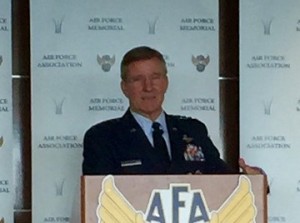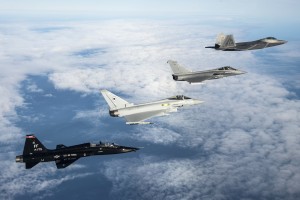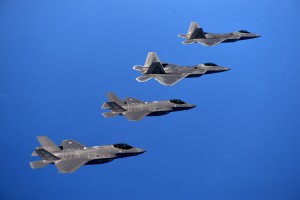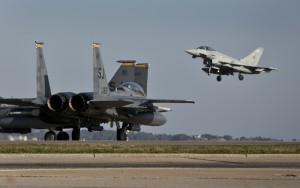2015-12-23 By Robbin Laird
© 2015 FrontLine Defence (Vol 12, No 6)
Counter-insurgency (COIN) warfare has been the dominant template in U.S. military engagements for more than a decade.
Joint warfare has been largely defined in terms of the air and naval services supporting the ground forces doing COIN.
COIN has become so dominate that the key elements of a fighting force have been crafted in its image with slow motion warfare, hierarchical C2, implementation of the OOLDA (Observe, Orient, Legally Review, Decide, and Act) loop which adds a review component to the previous quick-action OODA, K-Mart type of logistics support capabilities, significant numbers of Forward Operating Bases in the battlespace, and uncontested and uncontestable air space.
In a recent commentary by Francis Tusa, the age of COIN has been decisively replaced by the demands of what he refers to as hybrid warfare. “How much more hybrid can you get than the current situation over Syria?” he wrote. “The ‘traditional’ view of hybrid warfare is an enemy who exhibits elements of different parts of the conflict spectrum – some cyber, some conventional, some guerrilla,” he explained.
“But look at what US/French (and soon British…?) forces face over Syria today: a low level insurgent threat, which can exhibit some higher level capabilities, and then a very high intensity threat from Russian SAMs and combat aircraft. Not a hybrid threat from one foe, but made up of different enemies. That really is hybrid!”
Airpower in this context needs to seamlessly operate in all airspace – uncontested, contestable and contested. For the USAF, the coming of age of the F-22 provides a very flexible capability that enables the air combat force to operate in the quick turn quality of modern warfare.
Fifth generation aircraft are not widely understood in terms of how they really operate and how they change the capabilities of the air combat fleet. Stealth is a key element of being able to operate where you need to, when you need to, and do so with a modest operational footprint.
Rather than bringing airwings of specialized assets to fly with your fighters, to provide Electronic Warfare and ground defense protection against ground based air defense systems, F-22s and then F-35s can operate as multi-tasking aircraft that are able to operate in the contested battlespace.
To be clear, multi-tasking aircraft can operate as needed to provide a range of capabilities as the tasks change and evolve, compared to multi-mission aircraft which can operate to a task and often need to land and be quickly refitted for a different tasking as demanded. Multi-tasking means one platform, one pilot, can have the flexibility to operate in a rapidly evolving environment with lethality and mission effectiveness.
From interviews conducted in September and October 2015 at ACC, the Air Combat Command located at Langley Air Force base, I was updated on the F-22 and its role in enabling the air combat force. ACC is the primary provider of air combat forces to America’s warfighting commanders.

The first interview was with the Commander, General “Hawk” Carlisle, whose last command was as head of the Pacific Air Force. “It is important to look at the impact of the F-22 operations on the total force. We do not wish, nor do the allies wish to send aircraft into a contested area without the presence of the F-22,” he said.
“It’s not just that the F-22s are so good, it’s that they make every other plane better. They change the dynamic with respect to what the other airplanes are able to do because of what they can do with regard to speed, range, and flexibility.
“It’s their stealth quality. It’s their sensor fusion. It’s their deep penetration capability. It is the situational awareness they provide for the entire fleet, which raises the level of the entire combat fleet to make everybody better.
“The shift is to a new way of operating. What is crucial as well is training for the evolving fight, and not just remaining in the mindset or mental furniture of the past.
“It is about what needs to be done now and training towards the evolving and future fight.”
In the room, were pilots from the most recent operations in Iraq and Syria, and Carlisle gave an example of one F-22 pilot who, within a 12-hour mission during the night, variously conducted strike, ISR, and armed escort missions, including several air refuelings during the night mission over Syria and Iraq.
In a follow up interview at ACC, I was able, with my colleague Ed Timperlake, to follow up with several ACC pilots with regard to the way ahead for air combat power. In many ways, the combination of talents of the group reflects the evolution of the air force itself.

Among them was an F-22 and F-15 C requirements officer; an A-10 pilot and the point man for the forthcoming allied exercise at Langley, where the F-22, the Typhoon and the Rafale will fly together; an F-35 requirements and force networking officer; and experts on general air combat.
The exercise coming up at Langley in December 2015 will feature the F-22 flying with the Typhoon (XI Squadron from the RAF) and the Rafales from the French Air Force. What these three aircraft have in come is that they all are about 10 years old in terms of combat experience and life.
This is a good reminder that it takes a decade for a new combat aircraft to get its “combat legs,” so to speak, and to start to come into its own. And in this case, these three different aircraft, which will fly for the next 30 years together in combat. Training and forging common tactics is a core activity to shape overall capability for an air combat force.
The F-22 and its impact is a good case study in a key challenge facing the defense analytics community. The aircraft is not only stealthy but its impact has been even more so. The F-22 is a breakthrough capability in terms of it having redefined what a tactical fighter can do and what its impact can be.
As the A-10 pilot underscored, “fifth generation” is not really about its tactical effect, it is about its operational impact on the entire fleet. “Prior to the F-22, the individual pilot could only have a tactical effect. Now the pilot can have an operational effect. I can take a much smaller package to have a larger operational effect, which can have strategic impact. Four F-15Cs or four A-10s showing up does not have a strategic effect; four F-22s can have such an effect.”
The F-22 pilot in the room discussed how the aircraft has been used in the Middle East, and highlighted its flexibility in shifting from dropping weapons to providing force protection (including dealing with ground based threats to the air combat force), to becoming the air battle manager in contestable airspace. In other words, the F-22 is providing the mission assurance role for the air combat force.
This transformation has simply become part of operational practice; it is the quiet transformation that is infusing the USAF and the air combat force.

The F-22 pilot further highlighted that although sensor fusion can be considered a key attribute of fifth generation, the ability to fly where you need to go is a real discriminator. “It is about stealth-enabled sensor fusion; it’s not just about generating information in the battlespace. There are places where legacy aircraft simply cannot go and survive.”
The USAF started by shaping tactical integration of the F-22s with the F-15s. That was a key effort of the first five years of the life of the F-22. As one ACC participant commented: “We started by flying F-22s with F-15s; the F-22s went out, fired their weapons, had their impact, and returned home. The F-15s then fended for themselves, with not always good results, in our exercises. It did not take us very long to grasp that integrated tactics were required – where the F-22 enabled the F-15s and the F-15s supported the F-22s.”
The last five years have seen this type of tactical integration broaden out from the classic air superiority role, to encompass the broader force to enable the operational effects, which the A-10 pilot spoke about.
There are three broad impacts of this shift to fifth generation enablement for the force. The first is re-thinking the modernization strategy for 4th generation or legacy assets. As the F-15 C requirements pilot said: “When the USN gets a new carrier, the ships that cannot keep up get retired. The USAF needs a similar approach with regard to the intersection of fifth generation with legacy. But for those legacy assets to be modernized, we need to [do it in ways that are] complementarity to fifth generation.”

The F-15C requirements officer noted that the modernization strategy is no longer stove-piped. It is not about upgrading the F-15C for the air superiority mission, it is about upgrading to complement the fifth generation capability. “We are going to make it more interoperable with fifth-gen fighters so it can keep up, compliment that force, not operating alone (doing its own thing) but as part of the total package. If I can’t make it in such a way that the [C-model] can keep up and integrate fully with the fifth-gen fighters when asked to, then it is a sunset force.”
The second impact is re-working the interoperable air combat force. The officer working air combat integration highlighted the intersection between fifth generation aircraft and the reworking of the connected air combat force. To be clear, fifth generation aircraft are unique capabilities within an air combat force, not simply another data generator.
“Networking the force is a clear way ahead. Whether it is interconnecting the fifth generation force or connecting the fifth with the fourth generation, and being able to share information in a multinational environment, the challenge is to enhance the operational connectivity of the air combat force.
The implicit assumption is that everybody has some piece of a puzzle. Nobody has the whole thing, whether it’s a piece of identification, information, or weapons solution. How do we network between and among the various participants in this joint multinational force to get the results we need to have?”
The third impact is continuously evolving the integrated tactics of the air combat force as the fifth generation element grows in significance and impact. A key limit to the fifth generation cultural shift simply has been how few pilots exist for the F-22 and the spin-off effects from experienced F-22 pilots being available to shape the evolving combat culture.
In short, the F-22-enabled air combat force is here and operational. It provides a template for further innovation as legacy fleets are co-modernized with the software-upgradeable F-35 that are coming into global air combat forces.
Reprinted with the permission of our strategic partner Front Line Defence.
http://defence.frontline.online/article/2015/6/3711-Airpower-%26-the-Hybrid-Threat


